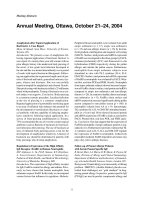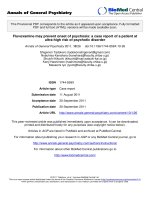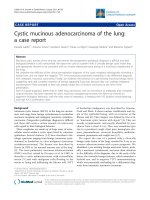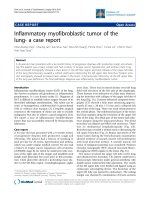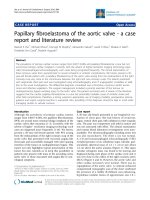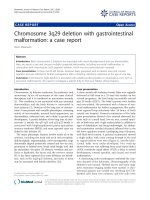Báo cáo y học: "Pica and refractory iron deficiency anaemia: a case report" pps
Bạn đang xem bản rút gọn của tài liệu. Xem và tải ngay bản đầy đủ của tài liệu tại đây (316.44 KB, 3 trang )
BioMed Central
Page 1 of 3
(page number not for citation purposes)
Journal of Medical Case Reports
Open Access
Case report
Pica and refractory iron deficiency anaemia: a case report
Christophe von Garnier*
1,2
, Holger Stünitz
3
, Michael Decker
4
,
Edouard Battegay
1
and Andreas Zeller
1
Address:
1
Medical Outpatient Department, University Hospital Basel, Petersgraben, 4031 Basel, Switzerland,
2
Respiratory Medicine, University
Hospital Bern, 3010 Bern, Switzerland,
3
Department of Geosciences, University of Basel, Bernouillistrasse, 4056 Basel, Switzerland and
4
Division
of Haematology, University Hospital of Basel, Petersgraben, 4031 Basel, Switzerland
Email: Christophe von Garnier* - ; Holger Stünitz - ;
Michael Decker - ; Edouard Battegay - ; Andreas Zeller -
* Corresponding author
Abstract
Introduction: Iron deficiency is the most common cause of anaemia worldwide. Pica, the
ingestion of substances that are inappropriate for consumption, is associated with iron deficiency
and may be under-diagnosed.
Case presentation: A 34-year-old woman presented with iron deficiency anaemia refractory to
treatment for more than a decade. The clinical presentation, endoscopic findings and laboratory
investigations were consistent with pica. Subsequent geophysical analysis confirmed that the
ingested material was kaolin, a negatively charged silicate.
Conclusion: Prolonged unexplained iron deficiency anaemia should prompt clinicians to
remember and inquire about pica. In our patient, this would have averted numerous unnecessary
investigations and prevented a decade-long suffering.
Introduction
Pica refers to an ill-defined entity known as a perverted
appetite for substances inappropriate for consumption,
such as kaolin (geophagia) [1]. Cultural factors may influ-
ence this dietary behaviour, which can even lead to seri-
ous complications that require surgical intervention [2,3].
Kaolinite is the most important component of kaolin, a
white chalky silicate used in the paper-coating industry, in
ceramics production and in the pharmaceutical industry.
The negatively charged surface of kaolinite is able to
exchange and adsorb cations (for example, Fe
2+
and Fe
3+
)
in the duodenum, where iron absorption occurs. As a con-
sequence, iron deficiency anaemia may be associated with
the ingestion of kaolin. We report the case of an African
woman who had lived in Europe for more than a decade
and presented with a 12-year history of seemingly refrac-
tory iron deficiency anaemia.
Case presentation
A 22-year-old African woman first presented to our medi-
cal outpatients department in 1993 with anaemia, with
test results as follows: haemoglobin (Hb) 96 g/litre (nor-
mal range 120 to 160 g/litre), mean corpuscular volume
(MCV) 74.7 fl (normal range 79 to 95 fl), mean corpuscu-
lar haemoglobin concentration (MCHC) 313 g/litre (nor-
mal range 320 to 360 g/litre), reticulocytes 13‰ (normal
range 5 to15‰) and ferritin of 9 ng/ml (normal range 10
to 200 ng/ml). Iron deficiency was the most likely cause,
but further investigations (occult stool blood test, gastros-
copy, colonoscopy, gynaecological examination, Hb elec-
Published: 6 October 2008
Journal of Medical Case Reports 2008, 2:324 doi:10.1186/1752-1947-2-324
Received: 18 April 2008
Accepted: 6 October 2008
This article is available from: />© 2008 von Garnier et al; licensee BioMed Central Ltd.
This is an Open Access article distributed under the terms of the Creative Commons Attribution License ( />),
which permits unrestricted use, distribution, and reproduction in any medium, provided the original work is properly cited.
Journal of Medical Case Reports 2008, 2:324 />Page 2 of 3
(page number not for citation purposes)
trophoresis) failed to show an obvious bleeding source or
abnormal Hb. Despite oral iron replacement therapy (160
mg of Fe
2+
daily), Hb values remained low (100 to 115 g/
litre) over the next 4 years, after which the patient was lost
to follow-up.
Twelve years later, in 2005, the patient presented with
incapacitating fatigue related to severe iron deficiency
anaemia (Hb 75 g/litre, MCV 64.6 fl, MCHC 299 g/litre,
reticulocytes 13‰, ferritin 6 ng/ml and soluble transfer-
rin receptor 13.4 mg/ml (normal range 2.2 to 4.5 mg/
ml)). Gastroscopy showed normal gastric mucosa and his-
tological evidence of a highly active gastritis with Helico-
bacter pylori infestation in biopsy samples. A capsule
endoscopy revealed several non-specific erythematous
mucosal changes in the bulbus duodeni not seen during
gastroscopy.
During a follow-up visit and further explicit questioning
about particular eating habits, the patient reluctantly dis-
closed an almost daily consumption of 'a friable stone'
over more than a decade. She reported having developed
a particularly strong craving for such stones, of which she
would suck on small pieces until these completely dis-
solved. She had acquired this habit 15 years ago in her
home country Cameroon, where consumption of stones
is common. To characterise the chalky stone (Figure 1),
we contacted our geosciences department. X-ray diffrac-
tion measurements confirmed that the substance was
essentially composed of kaolinite with traces of quartz
(Figure 2). After cessation of kaolinite ingestion, we
administered intravenous iron replacement therapy (total
of 1000 mg) and the anaemia was corrected within 1
month (Hb 125 g/litre, MCV 79.4 fl, MCHC 333 g/litre,
ferritin 13 ng/ml, soluble transferrin receptor 6.6 mg/ml).
Tests 3 months later showed a stable blood count and iron
studies as follows: Hb 120 g/litre, MCV 83.6 fl, MCHC
346 g/litre, ferritin 11 ng/ml and soluble transferrin recep-
tor 6.0 mg/ml.
Discussion
The word pica comes from the Latin word for magpie, a
bird known for its unusual eating habits. Pica is character-
ised by persistent craving and compulsive eating of non-
food substances. Pica in humans has many different sub-
groups, defined by the substance that is ingested. Exam-
ples of pica are eating earth, soil or clay (geophagia) or ice
(pagophagia). The prevalence and type of pica depend on
ethnic and cultural factors that affect dietary practices [4].
Pica has been reported to be associated with severe iron
deficiency anaemia in up to half of patients; however, it is
unclear whether pica causes or is the consequence of iron
deficiency anaemia [5-8]. In our case, there are several rea-
sons why kaolin ingestion may have caused iron defi-
ciency anaemia. First, experimental data from kaolin-fed
pregnant rats showed significant maternal anaemia and
reduced birth weight, both of which were prevented in the
iron-supplementation control group [9]. Second, adsorp-
tion of Fe
2+
and Fe
3+
to the negatively charged and large
active surface area of kaolinite may lead to a reduction of
available iron in the duodenum. As a consequence, the
absorption of iron might decrease, resulting in iron defi-
ciency. Third, traces of quartz commonly found in kaoli-
nite may cause abrasion and favour increased mucosal
sloughing and iron loss. Fourth, kaolin consumption and
geophagia may cause parasitic infestation and further iron
loss [7-10].
Although pica is a rare condition in central Europe [11], it
may be underestimated in multicultural societies and it is
therefore important to remember and inquire about par-
ticular eating habits in the context of unexplained iron
deficiency anaemia. Thus, proper history remains the
most inexpensive investigation.
Conclusion
In the context of an unexplained iron deficiency anaemia,
it is important to remember and inquire about pica. In our
patient, this would have averted numerous unnecessary
investigations and prevented a decade of suffering.
Abbreviations
Hb: haemoglobin; MCHC: mean corpuscular haemo-
globin concentration; MCV: mean corpuscular volume.
Competing interests
The authors declare that they have no competing interests.
The stone consumed by the patientFigure 1
The stone consumed by the patient. Scale in centime-
tres.
Journal of Medical Case Reports 2008, 2:324 />Page 3 of 3
(page number not for citation purposes)
Consent
Written informed consent was obtained from the patient
for publication of this case report and any accompanying
images. A copy of the written consent is available for
review by the Editor-in-Chief of this journal.
Authors' contributions
CVG managed the patient, conceived the initial idea and
drafted the paper. HS performed and interpreted the geo-
physical investigations. MD reviewed and interpreted the
full blood counts and iron studies. EB critically reviewed
and interpreted the investigations. AZ managed the
patient and critically reviewed the manuscript. All authors
read and approved the final manuscript.
Acknowledgements
We thank Daniel Boller, Gastroenterology Division, Basel University Hos-
pital, for performing and interpreting the gastroscopy, colonoscopy and
capsule endoscopy.
References
1. Lacey EP: Broadening the perspective of pica: literature
review. Public Health Rep 1990, 105:29-35.
2. Anderson JE, Akmal M, Kittur DS: Surgical complications of pica:
report of a case of intestinal obstruction and a review of the
literature. Am Surg 1991, 57:663-667.
3. Grigsby RK, Thyer BA, Waller RJ, Johnston GA Jr: Chalk eating in
middle Georgia: a culture-bound syndrome of pica? South
Med J 1999, 92:190-192.
4. Simpson E, Mull JD, Longley E, East J: Pica during pregnancy in
low-income women born in Mexico. West J Med 2000,
173:20-24.
5. Coltman CA Jr: Pagophagia and iron lack. Nutr Rev 1969, 27:244.
6. Crosby WH: Food pica and iron deficiency. Arch Intern Med 1971,
127:960-961.
7. Geissler PW, Mwaniki DL, Thiong'o F, Michaelsen KF, Friis H:
Geophagy, iron status and anaemia among primary school
children in Western Kenya. Trop Med Int Health 1998, 3:529-534.
8. Lanzkowsky P: Investigation into the aetiology and treatment
of pica. Arch Dis Child 1959, 34:140-148.
9. Patterson EC, Staszak DJ: Effects of geophagia (kaolin ingestion)
on the maternal blood and embryonic development in the
pregnant rat. J Nutr 1977, 107:2020-2025.
10. Geissler PW, Mwaniki D, Thiong F, Friis H: Geophagy as a risk fac-
tor for geohelminth infections: a longitudinal study of Ken-
yan primary schoolchildren. Trans R Soc Trop Med Hyg 1998,
92:7-11.
11. Schnuelle P, Oberheiden T, Hohenadel D, Gottmann U, Benck U,
Nebe T, Krammer HJ, Woude FJ van der, Birck R: An unusual case
of severe iron deficiency anaemia. Gut 2006, 55:1060.
X-ray diffraction data for the kaolin stone sampleFigure 2
X-ray diffraction data for the kaolin stone sample. X-ray diffraction data of the sample material provided by the patient
(Cu-Kα1 irradiation, 2θ range 1° to 50°). The vertical lines mark the kaolinite peaks, all others correspond to quartz-specific
peaks.
